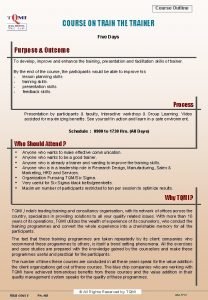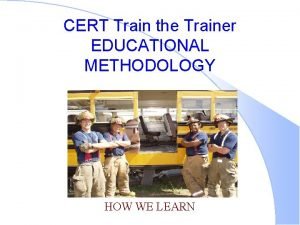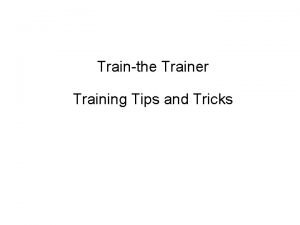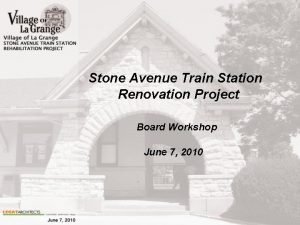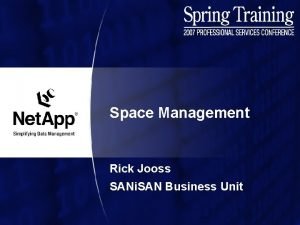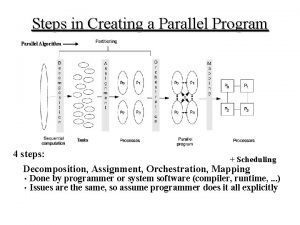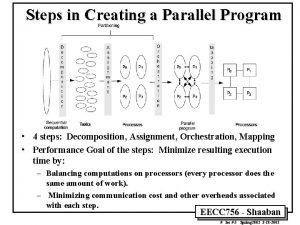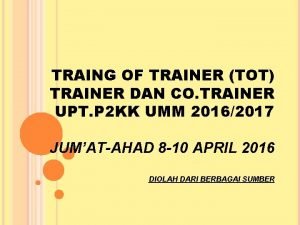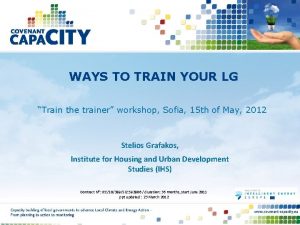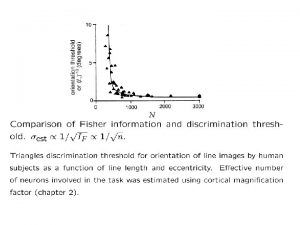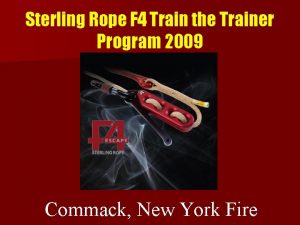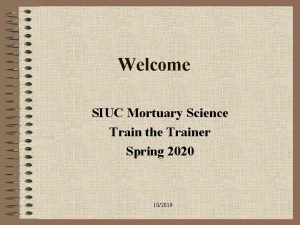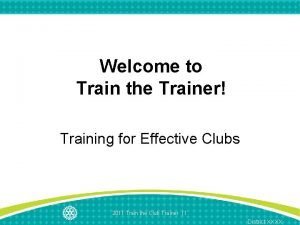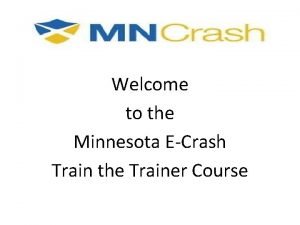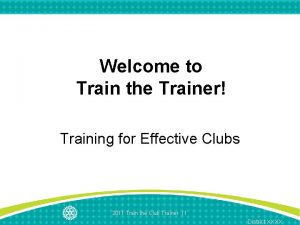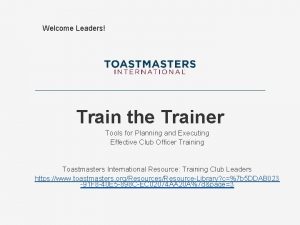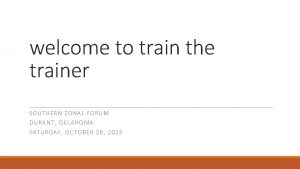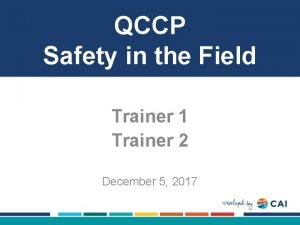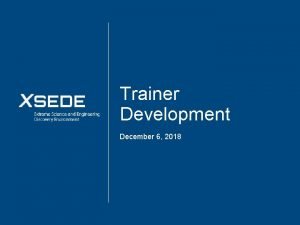WELCOME Creating Space Train the Trainer Program for





















- Slides: 21

WELCOME Creating Space Train the Trainer Program for Dialogue August 27 -31, 2018 4 H National Center Chevy Chase, MD

Guidelines • • • Try On It’s Ok to Disagree It’s not Ok to blame, shame or attack – self or others Practice Self-focus Share time and space Practice “both/and” thinking Don’t freeze each other in time Be aware of intent and impact Expect/accept discomfort and unfinished business Maintain Confidentiality

Moving from Debate to Dialogue Conventional Process Understanding Process • • • One right answer • Goal is to be right, win or • persuade • Evaluating and critical • What’s wrong with this • picture? Listen judgmentally, for errors • • and flaws Plan your rebuttal Multiple and valid perspectives Goal is to understand Curious and open What can I learn? Listen for their story Listen more than you talk Reflect instead of react Flick, 1998

Sources of Work • Dr. Becky Smith, Assistant Extension Professor Mississippi State University • • Boy Scouts of America Wood Badge Training Dr. Cade Smith, Director Student Leadership and Community Engagement Mississippi State University • W. K. Kellogg Foundation Racial Healing Circles

Understanding Our Brains • Our brains are our operating systems, but we have not had an update for thousands of years. • Greatest threat was to be thrown out of the tribe. • Decision-making was focused on responses and actions to survive with few decisions to be made. • • Lots of decisions have to be made today Example, there was no advantage to saving in the ancient brain

Human Brain Is Inefficient at These Things We Need For Today's World • Meditation / Mindfulness • Diet • Exercise • Acceptance Tribalism (racism) • Sexism • Paternalism • Monogamy • Prudent financial behaviors (budgeting, saving) •

Brain Structure: Threat Monitoring, Memory, and Executive Function • Amygdala – rapid ‘threat system’ constantly monitoring for danger. Poor discriminator of real threats vs. perceived threats inside our head. • Hippocampus – memory storage and retrieval • Prefrontal Cortex – executive function region: processes emotions, reason & objectivity, goal direction, future consequences, social control

Emotional Resiliency in Uncomfortable Situations • Reduce Amygdala’s threat assessment • Under acute threat the higher order brain shuts down and we enter fight, flight, or freeze modes • Below threshold threat, higher order brain active • Allow Hippocampus to retrieve old and store new memories • Engage executive functions of Prefrontal Cortex - Process emotions (empathy and compassion), objective thought, consider future outcomes, goal orientate behavior

Implicit Bias: What Is It? • Dominant Cultural Norms • • • Non-Target Group: What dominate cultural norms defined as valuable and desirable Target Group: Non-typical people and groups are less preferred Human Tendency to: • • Trust and value things that are culturally normative Trust things less that are not

Implicit Bias (cont’d. ) • We all have “implicit bias. ” • It is hard to see our implicit biases. • Understanding helps us slow our decision-making to align with our true values.

What Can We Do? How do we take this corrupted software and use it so we do okay and thrive in today's world? • Recognize that we hold biases. • Spend time owning and not denying • Spend time with others who are different from us, dealing with our fears, becoming one tribe But, this is hard—how do we do it?

Our Brains and Feeling Threat “Feeling I can trust you is more important than thinking I can trust you. ” When considering trusting someone, how accurate is this statement for you?

Building Trust How important is listening in building trust? • What is happening when you are listening well? • What is happening when you are NOT listening well?

1 4 Listening to Learn and Understand

1 5 Listening to Learn and Understand • Solutions appear through listening. • “Seek first to understand, then to be understood. ” Stephen Covey • How do you respond when you hear something you don’t want to hear? • Many of us… • Have blank looks, interrupt, and are distracted • Are simply waiting to be able to say something rather than listening to learn and understand • Especially when we feel tired, hungry, angry, or threatened • Tip: take a break and take care of yourself so you can be in a better place to listen Source: Boy Scouts of America Wood Badge

1 6 Two Types of Listening 1. Active Listening • Reflect back, “What I understand you to say is…” • No moral judgments, just restate 2. Empathetic Listening • Understand the depth of what is said • More than just listening to the words, what is the message? • Put self in place of the speaker

1 7 Process: Pair, Share, Listen, Reflect, and Affirm 1. (3 min) Thoughtfully consider the question 2. (2 min) Partner #1 shares and Partner #2 listens to learn and understand 3. (1 min) Partner #2 reflects back to Partner #1 what was heard and finds something to affirm 4. (2 min) Partner #2 shares and Partner #1 listens to learn and understand 5. (1 min) Partner #1 reflects back to Partner #2 what was heard and finds something to affirm

1 8 Prompt 1: Describe a time when you had something very important to say and you have been prevented from being heard and/or invalidated. Be specific… • Describe what happened? • How did it feel? Where in your body did you feel it? • If it had smell, how would it have smelled? • If it had taste, how would it have tasted? • What did you want to do because of it?

1 9 Power of Being Heard

2 0 Perspective Taking and Perspective Giving • • Perspective Taking - Making an effort to understand another person’s perspective and point of view Perspective Giving - Embracing the opportunity to share one’s own story with someone else

2 1 Emile Bruneau: Lessons Learned • It is important for both groups to give perspectives. • Attitudes toward the other group improved the most when disempowered shared their stories and the empowered group listened. • The less empowered group benefits more from perspective giving • The dominant group benefits more from perspective taking http: //news. mit. edu/2012/conflict-resolution-0315
 Train the trainer training program outline
Train the trainer training program outline Train the trainer objectives
Train the trainer objectives Cert train the trainer
Cert train the trainer Train the trainer agenda
Train the trainer agenda Trainthe trainer
Trainthe trainer Stone avenue train station
Stone avenue train station Sani creating space
Sani creating space What is the correct steps in creating a parallel program
What is the correct steps in creating a parallel program What is the correct steps in creating a parallel program
What is the correct steps in creating a parallel program Welcome welcome this is our christmas story
Welcome welcome this is our christmas story Formuö
Formuö Typiska drag för en novell
Typiska drag för en novell Tack för att ni lyssnade bild
Tack för att ni lyssnade bild Ekologiskt fotavtryck
Ekologiskt fotavtryck Varför kallas perioden 1918-1939 för mellankrigstiden
Varför kallas perioden 1918-1939 för mellankrigstiden En lathund för arbete med kontinuitetshantering
En lathund för arbete med kontinuitetshantering Särskild löneskatt för pensionskostnader
Särskild löneskatt för pensionskostnader Personlig tidbok för yrkesförare
Personlig tidbok för yrkesförare Sura för anatom
Sura för anatom Förklara densitet för barn
Förklara densitet för barn Datorkunskap för nybörjare
Datorkunskap för nybörjare Boverket ka
Boverket ka
